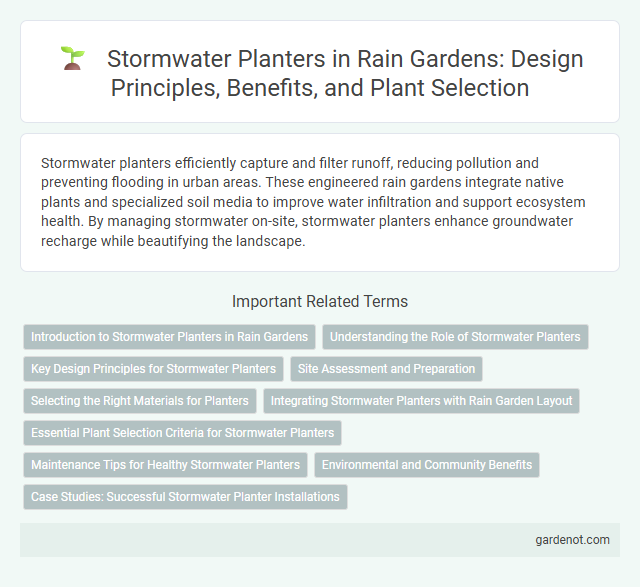Stormwater planters efficiently capture and filter runoff, reducing pollution and preventing flooding in urban areas. These engineered rain gardens integrate native plants and specialized soil media to improve water infiltration and support ecosystem health. By managing stormwater on-site, stormwater planters enhance groundwater recharge while beautifying the landscape.
Introduction to Stormwater Planters in Rain Gardens
Stormwater planters in rain gardens are engineered landscaping features designed to capture, filter, and manage urban runoff efficiently. These planters utilize a combination of engineered soils, native vegetation, and permeable materials to reduce pollutants and promote groundwater recharge. Integrating stormwater planters helps mitigate flooding, improve water quality, and support sustainable urban drainage systems.
Understanding the Role of Stormwater Planters
Stormwater planters play a crucial role in managing urban runoff by capturing and filtering stormwater before it enters the drainage system. These engineered landscapes use plants and soil media to reduce pollutants, improve water quality, and mitigate flooding in densely developed areas. Incorporating stormwater planters into urban infrastructure supports sustainable water management and enhances ecological resilience.
Key Design Principles for Stormwater Planters
Stormwater planters require key design principles such as incorporating an engineered soil mix that promotes infiltration and supports plant growth, ensuring proper underdrain systems facilitate efficient water drainage, and including an overflow mechanism to manage excess stormwater. Vegetation selection should focus on native, water-tolerant species that can withstand both wet and dry conditions, enhancing pollutant removal and biodiversity. Proper sizing based on local rainfall intensity, drainage area, and soil infiltration rates is essential to maximize stormwater retention and pollutant filtration efficiency.
Site Assessment and Preparation
Site assessment for a stormwater planter involves evaluating soil permeability, drainage patterns, and slope to ensure efficient water infiltration and prevent oversaturation. Proper preparation includes amending soil with organic matter to enhance filtration and creating an underdrain system if necessary to manage excess runoff. Selecting a location near downspouts or impervious surfaces maximizes stormwater capture and reduces urban runoff impact.
Selecting the Right Materials for Planters
Choosing durable, permeable materials such as porous concrete, recycled plastic, or natural stone enhances water infiltration and longevity in stormwater planters. Incorporating native soil mixed with organic compost improves nutrient retention and supports healthy plant growth within the planter system. Selecting materials resistant to erosion and UV damage ensures structural integrity and reduces maintenance in rain garden environments.
Integrating Stormwater Planters with Rain Garden Layout
Stormwater planters enhance rain garden effectiveness by strategically capturing and filtering runoff from impervious surfaces such as roofs and sidewalks. Integrating these planters within rain garden layouts optimizes water retention and pollutant removal through layered soil media and native vegetation. Proper design alignment ensures improved infiltration rates, reduced urban flooding, and increased groundwater recharge, maximizing the ecological benefits of stormwater management systems.
Essential Plant Selection Criteria for Stormwater Planters
Selecting plants for stormwater planters requires prioritizing species with high tolerance to fluctuating moisture levels, including periods of both saturation and drought. Native, deep-rooted perennial plants excel at promoting infiltration, trapping sediments, and absorbing nutrients, which enhances water quality and reduces runoff. Choosing species with robust root systems and adaptability to urban environments ensures long-term functionality and resilience of stormwater management systems.
Maintenance Tips for Healthy Stormwater Planters
Regular inspection and removal of debris ensure optimal water infiltration in stormwater planters. Mulching with organic materials helps retain moisture and suppress weed growth, promoting healthy plant roots. Seasonal pruning and replacing dead plants maintain filtration efficiency and overall planter health.
Environmental and Community Benefits
Stormwater planters effectively filter and absorb rainwater, reducing urban runoff and preventing pollutants from entering local waterways. These green infrastructures enhance groundwater recharge and improve air quality by trapping dust and particulate matter. Communities benefit from increased biodiversity, cooler urban temperatures, and aesthetically pleasing spaces that promote social interaction and environmental awareness.
Case Studies: Successful Stormwater Planter Installations
Stormwater planter installations have demonstrated effective urban water management in numerous case studies, showcasing significant reductions in runoff volume and pollutant loads. Successful projects, such as those in Portland, Oregon, and Seattle, Washington, highlight enhanced infiltration rates and improved water quality through native plant selections and engineered soil media. These implementations provide replicable models for municipalities aiming to mitigate stormwater impacts while enhancing urban green infrastructure.
Stormwater planter Infographic

 gardenot.com
gardenot.com